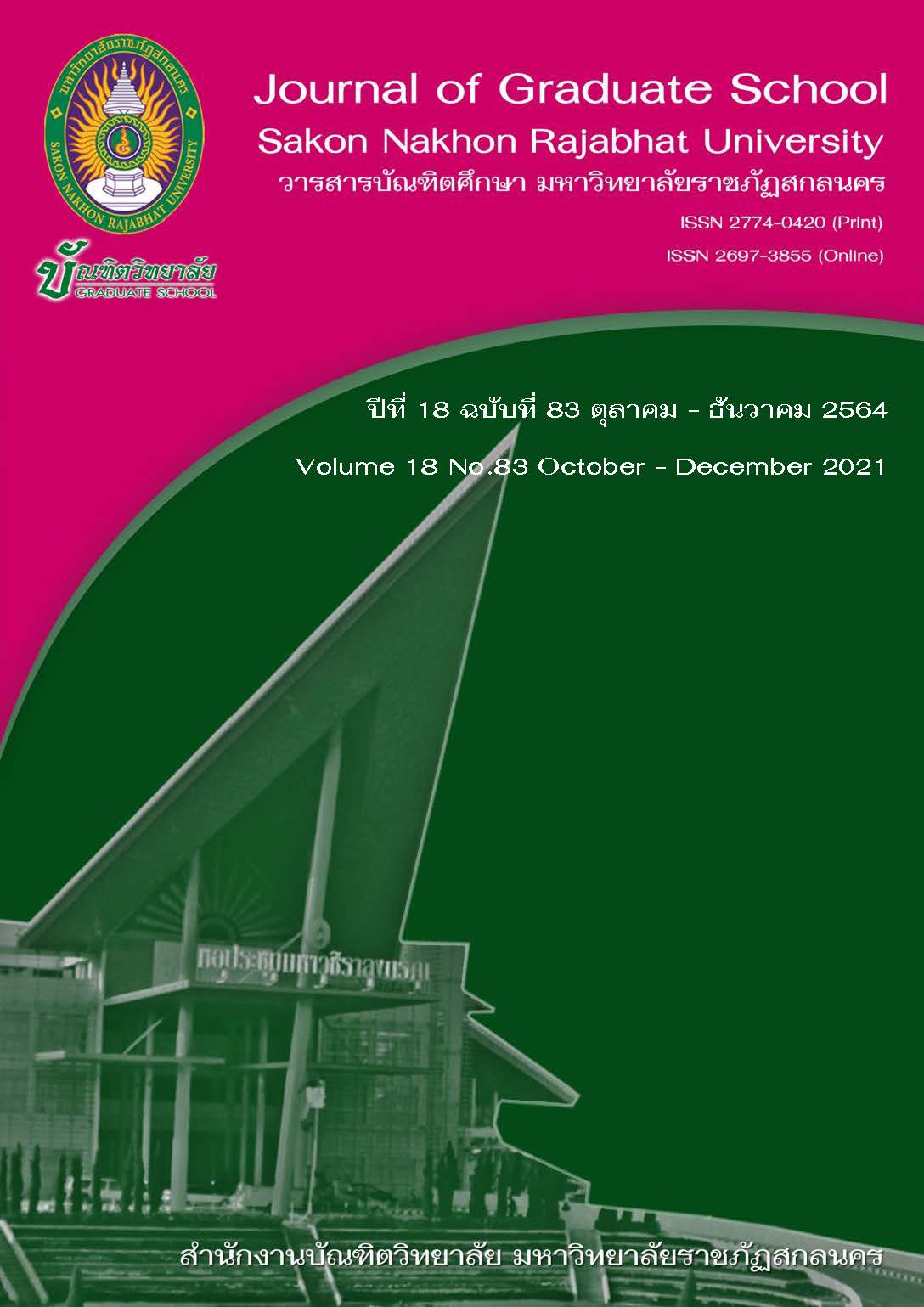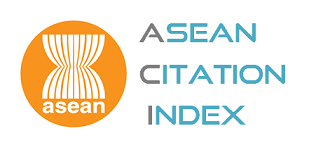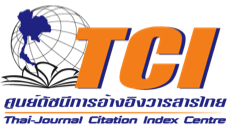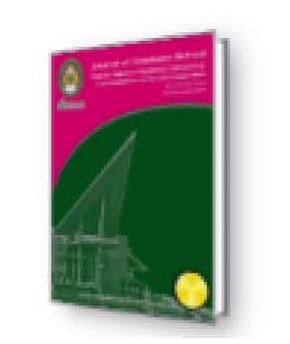การพัฒนาความคิดสร้างสรรค์ของเด็กปฐมวัยด้วยการจัดประสบการณ์การเรียนรู้ ตามแนวสะเต็มร่วมกับนิทานสำหรับเด็ก
Keywords:
Creativity, STEM Based Learning Experience Combined with Fairy Tales for Children, Early ChildhoodAbstract
The objectives of this research were: 1) to develop creativity of early childhood through a STEM based learning experience combined with fairy tales for children, and 2) to compare early childhood’s creativity before and after the intervention. The sample consisted of a mixed-gender group of 22 early childhood students at the age of 5 years attending the second year of kindergarten in the first semester of the academic year 2020 at a school in the Tha Sala Network 2 under Nakhon Si Thammarat Primary Educational Service Area Office 4. The sample was obtained through simple random sampling; and their class was employed as the sampling unit. The research instruments consisted of eight lesson plans with 20 hours, a set of the Test for Creative Thinking Drawing Production (TCT DP), a product evaluation form, and a learning behavior observation form. The data were analyzed by percentage, mean, standard deviation, and t-test for Dependent Samples. The research results were as follows: 1. The creativity features were more highly developed in early childhood students who experienced the class of the STEM based learning experience combined with the fairy tales for children. 2. The posttest scores of early childhood students’ creativity after the intervention were higher than the pretest scores at the .05 level of significance.
References
กระทรวงศึกษาธิการ. (2561). คู่มือหลักสูตรการศึกษาปฐมวัยพุทธศักราช 2560 (สำหรับเด็กอายุ 3-5 ปี). กรุงเทพฯ: โรงพิมพ์คุรุสภา.
เกียรติวรรณ อมาตยกุล. (2553). สอนให้เป็นอัจฉริยะตามแนวนีโอฮิวแมนนิส. (พิมพ์ครั้งที่ 7). กรุงเทพฯ: ภาพพิมพ์.
ชลาธิป สมาหิโต. (2557). เอกสารประกอบการอบรมเชิงปฏิบัติการ การจัดกิจกรรมบูรณาการวิทยาศาสตร์ เทคโนโลยี วิศวกรรมศาสตร์ และคณิตศาสตร์สำหรับปฐมวัย. เมื่อวันที่ 18 มกราคม และ 8 กุมภาพันธ์ พ.ศ. 2557 ณ สมาคมอนุบาลแห่งประเทศไทย.
_______. (2560). การจัดประสบการณ์การเรียนรู้โดยใช้ปัญหาเป็นฐาน (Problem-Based Learning) ผ่านการเล่านิทานสำหรับเด็กปฐมวัย. วารสารวิทยบริการมหาวิทยาลัยสงขลานครินทร์, 28(3), 177-184.
ทวีศักดิ์ จินดานุรักษ์. (2558). การคิดสร้างสรรค์ในศาสตร์การคิด. กรุงเทพฯ: มหาวิทยาลัยธุรกิจบัณฑิตย์.
เบญจกาญจน์ ใส่ละม้าย และชลาธิป สมาหิโต. (2558). การพัฒนาความคิดสร้างสรรค์ สำหรับเด็กปฐมวัย โดยผ่านการจัดประสบการณ์การเรียนรู้แบบสะเต็มศึกษา เรื่อง อาชีพในท้องถิ่น จังหวัดสงขลา. วารสารวิทยบริการ, 26(2), 104-110.
ยศวีร์ สายฟ้า. (2556). แนวคิดการจัดการเรียนรู้แบบ STEM. เอกสารประกอบการสอนสาขาวิชาประถมศึกษา. กรุงเทพฯ: คณะครุศาสตร์ จุฬาลงกรณ์มหาวิทยาลัย.
สุวรรณา ก้อนทอง. (2547). ผลการจัดกิจกรรมศิลปะประกอบเสียงดนตรีคลาสสิกที่มีต่อความคิดสร้างสรรค์ของเด็กปฐมวัย. ปริญญานิพนธ์ กศ.ม. กรุงเทพฯ: มหาวิทยาลัยศรีนครินทรวิโรฒ.
เสาวภากุล จันทร์ทิพย์. (2556). ผลการจัดกิจกรรมศิลปะ การปั้นดินนํ้ามันแบบธรรมชาติเน้นการใช้คําถามที่มีต่อความคิดสร้างสรรค์และพฤติกรรมกลุ่ม ของเด็กปฐมวัย. วิทยานิพนธ์ ค.ม. อุดรธานี: มหาวิทยาลัยราชภัฏอุดรธานี.
อมรรัตน์ จำปาวัตตะ ถาดทอง ปานศุภวัชร และนิติธาร ชูทรัพย์. (2562). การพัฒนาความคิดสร้างสรรค์ของนักเรียนชั้นประถมศึกษาปีที่ 3 เรื่อง วัสดุและวัตถุ โดยการจัดการเรียนรู้แบบสะเต็มศึกษา. วารสารวิชาการหลักสูตรและการสอน มหาวิทยาลัยราชภัฏสกลนคร, 11(31), 59-70.
Guilford, J. P. (1967). The Nature of Human Intelligence. New York: McGraw–Hill.
Jellen, H. and Urban, K.K. (1986). The TCT-DP (Test for Creative Thinking - Drawing Production): An instrument that can be applied to most age and ability groups. Creative Child and Adult Quarterly, 11, 138-155.
Downloads
Published
How to Cite
Issue
Section
License
บทความทุกบทความที่ตีพิมพ์ในวารสารบัณฑิตศึกษา มหาวิทยาลัยราชภัฏสกลนคร ถือว่าเป็นลิขสิทธิ์ของบัณฑิตวิทยาลัย มหาวิทยาลัยราชภัฏสกลนคร










